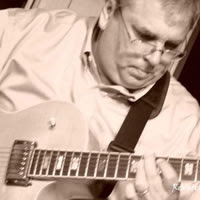Someone at rec.music.makers.guitar.jazz brought up switching to a 3 fingered left hand approach from a 4 fingered approach. Below are my thoughts:
I've spent most of my guitar playing time using the four finger approach but when I developed an interest in Django and then Wes I wanted to investigate the differences.
I've also used the Garrison Fewell books and agree with others in that I believe they are superb. They have helped me a great deal.
In studying the Django approach, I've also used books from Mike Horowitz (djangobooks.com) and his cohorts. They are the most helpful in understanding that style than others' books I've studied.
Some conclusions I've come to:
The 4 finger CAGED and Leavitt approach is a more mastering music on your instrument sort of approach. More of an approach where that is more open to possibilities musically. It's not so much about jazz as it is about having a good way to master playing the guitar in a variety of styles.
The 3 finger approach is something I think more of as a guitar styles approach as opposed to the "all music" approach. I don't think it's based as much as playing scales in positions. Trying to adapt in that direction from the 4 finger approach is almost fruitless. The 3 finger approach is typically more about phrases and arpeggios than scales - which may be one reason why people might consider it to be more musical.
On reflection - I did a lot of scale learning starting from the lowest note in a position, playing to the top of that position and then descending again. This is pretty contrary to what most of us would call good music. When I experimented with keeping my soloing to the top 4 strings I felt things came into focus a little better. Especially in respect to what some of the great guitar stylists do. (I still have a strong tendency to "over scale" in my improvising when I don't really have a good musical thought - i.e. most of the time).
Another big part is how you hold the instrument (or posture). There are several variables in this, but take note of how Django and Wes held their guitars - pretty much with the neck almost parallel to the floor. It's nearly impossible (if not impractical) to work through the Leavitt system like this. Of course there are exceptions (Tal Farlow comes to mind - I understand he had really big hands). The neck down approach is naturally more limiting and hence could lead to more of a guitar style. It also involves having to use a tilted left (fingering) hand technique. The neck up postion - more like a classical posture - is more suited to a variety of fingerings all over the neck. Also the left hand can use more of a perpendicular or right angle approach, as well as a tilted left hand if so desired.
The lowered neck approach has a similar affect has tilting the neck up but holding the body of the instrument lower instead of up closer to the chest.
In summary:
3 finger approach and posture - stylistically limiting but perhaps more musically compelling.
4 finger approach and posture - probably more adaptable to more music.
One more thing in closing - It's pretty difficult if not impossible to get far with a new approach, technique, style, whatever, without giving yourself over to it totally, as in leaving the old approach behind. The times I've had some success in learning a new style, I've done it by restricting myself to only that. If you're currently working steadily then trying to add a playing style that requires different techniques and fingerings, will likely be pretty frustrating.
Tuesday, May 31, 2011
Subscribe to:
Comments (Atom)



